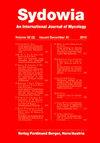在创记录的暖期,南落基山脉出现了共生山松甲虫
IF 1.2
4区 生物学
Q4 MYCOLOGY
引用次数: 5
摘要
我们研究了科罗拉多州三种松树流行种群下降的山松甲虫的蓝染真菌(蛇孔虫科:蛇孔虫科)。利用形态学和分子特征,我们确定了在科罗拉多州洛基山脉南部存在互利共生的L. longiclavatum,在那里它和适应温暖温度的O. montium一样普遍存在于昆虫专门的上颌菌丝体中。该物种比其“兄弟种”G. clavigera更为普遍,G. clavigera是在美国种群中记录的常见的mycysial共生物种。研究结果是在两年的时间内得出的,其中包括该州有记录以来最热的一年(即2012年)。其他研究表明,在加拿大北部落基山脉的昆虫种群中,长柱状真菌更常见,在该山脉的南部地区逐渐减少,这表明纬度影响了这种真菌共生菌的频率,因为它具有更好的低温耐受性。我们的研究结果表明,科罗拉多的菌株可能比来自北方的菌株更能忍受温暖的温度。这些发现也增加了我们对物种分布和在加拿大落基山脉以南地区允许其发生的原地条件的了解。本文章由计算机程序翻译,如有差异,请以英文原文为准。
Mountain pine beetle mutualist Leptographium longiclavatum presence in the southern Rocky Mountains during a record warm period
We studied blue-stain fungi (Ophiostomataceae: Ophiostomatales) of mountain pine beetle in declining epidemic populations affecting three pine species in Colorado. Using morphological and molecular characterizations, we determined the presence of the mutualist L. longiclavatum in the southern Rocky Mountains of Colorado, where it was as common as the warm temperature adapted O. montium within the insect’s specialized maxillary mycangium. The species was more prevalent than its “sibling species” G. clavigera which is the the common mycangial mutualist documented in USA populations. Findings were made during a two-year period including the warmest year on record in the state (i. e., 2012). Other studies have indicated that L. longiclavatum is more frequent in insect populations occurring in the northern Canadian Rockies diminishing in southern areas of that mountain range, suggesting latitude influences the frequency of this fungal mutualists, due to its better cool temperature tolerances. Our findings suggest Colorado isolates may have a greater tolerance of warmer temperatures than those from the north. These findings also increase our knowledge about the species distribution and the in situ conditions permissive of its occurrence in areas south of the Canadian Rockies.
求助全文
通过发布文献求助,成功后即可免费获取论文全文。
去求助
来源期刊

Sydowia
生物-真菌学
CiteScore
3.30
自引率
10.00%
发文量
0
审稿时长
>12 weeks
期刊介绍:
Sydowia publishes reports of original research relevant to fungal taxonomy, systematics, evolution, structure, development, ecology, pathology (plants, animals, humans), and biotechnological applications. Reviews are published in areas of particular interest and current importance, but authors should consult the Editor before submitting a review manuscript. One volume of the journal, comprising two issues, is published each year. The official journal language is English. Submission of a manuscript to the Executive Editor implies that the results have not been previously published or simultaneously submitted to any other scientific journal, except as an abstract. When the authors are in doubt as to the suitability of their papers for Sydowia, the Editor of the journal should be consulted before submission of the manuscript.
All authors of a manuscript must have agreed to its submission and are responsible for its content. An author is one who has substantially contributed to the overall design and execution of the experiments. Individuals who supplied materials or critiqued the paper may be recognised in the acknowledgement section.
 求助内容:
求助内容: 应助结果提醒方式:
应助结果提醒方式:


